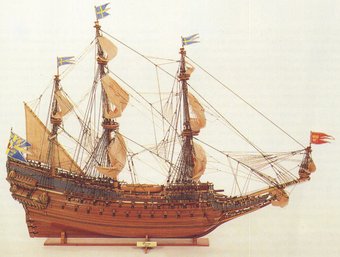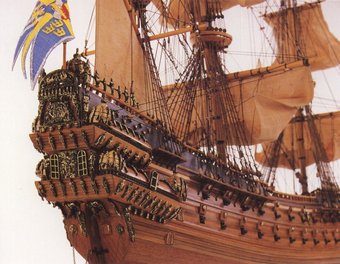Wasa
| Size | M | L | Price | ||
| Length | 96 cm | 60 cm | M | € 2.450 - 2.800 | |
| Height | 76 cm | 48 cm | L | € 4.410 - 5.040 | |
| Width | 33 cm | 22 cm | |||
 Geschichte
Geschichte 
Während des Dreißigjährigen Krieges befahl König Gustav Adolph von Schweden den Bau einer beträchtlichen Anzahl großer Kriegsschiffe. Dazu gehörte auch die WASA, die sich bereits im Bau befand und ursprünglich N.Y. WASSAN genannt werden sollte. Die Gesamtkosten für den Bau des Schiffes beliefen sich auf etwa 100.000 kaiserliche Taler. Am 31. Juli 1628 waren alle Kanonen an Bord, und am 10. August 1628 zwischen 15:00 und 16:00 Uhr trat die WASA ihre Jungfernfahrt an. Als sie schon weit draußen auf dem Meer war, fing sie den Wind mit ihren Segeln ein. Einige Minuten später zwang ein plötzlicher Sturm das Schiff auf die Seite, aber erste Versuche, sie wieder aufzurichten, blieben erfolglos. Durch die offenen Schießscharten, deren unterste Reihe nur etwa 1,20 m bis 1,50 m über dem Wasserspiegel lag, traten riesige Wassermengen ein. Nahe der Insel Beckholmen sank die WASA auf 32 m Wassertiefe. Die Bergungsarbeiten begannen am 13. August 1628 und es gelang die WASA wieder auf den Kiel zu legen. Jedoch konnte sie selbst mit Hilfe von zwei Pontons am 20. August 1959 nicht angehoben werden. Nach 28 Tagen zog ein Schlepper die WASA 500 m in seichtes Wasser. Bis zum 24. April 1961 waren alle Vorbereitungen für das Herausheben der WASA aus dem Wasser abgeschlossen. Am 4. Mai 1961 fuhr das Schiff auf eigenem Kiel in ein Trockendock. In der Zwischenzeit war ein riesiger Betonponton gebaut worden, der bald darauf zum ständigen Wohnsitz des Schiffes wurde. Dass es die WASA heute noch gibt, ist ganz dem kalten Wasser der Ostsee zu verdanken, in dem der Schiffsbohrwurm (teredo navalis) nicht überleben kann. Die WASA ist das älteste erhaltene und vollständig identifizierte Schiff, das heute bekannt ist. Es befindet sich in der WASA-Werft in Stockholm.
Prices
All stated prices are quoted for home delivery. NOT included are local taxes and customs duties. On request we can offer prices for any place in the world!
The exact price for each ship model depends on the transport cost and on the currency exchange rate on the day of purchase. The prices quoted on this website show an approximate price for each model; an exact quotation can be given on request. The experience shows that the exact quoted price is within the given range in 98 % of all inquiries.
Delivery
Each ship model is made by hand with hundreds of man-hours. Depending on the complexity of the ship please allow 4-8 weeks for delivery. Models are shipped safely with specially designed packaging for safe delivery and easy unpacking.
Payment
50 % upon confirmation of order; 50 % on delivery; by SWIFT transfer.
Wasa - Detail
 History
History 
During the Thirty Years' War King Gustavus Adolphus of Sweden ordered the building of a considerable number of large warships. They included the WASA which was already under construction and was originally to be called NY WASSAN. The total cost of building the vessel was approximately 100,000 imperial talers. By July the 31st of 1628 all the cannons were on board and an the 10th of August of 1628 between 3 p.m. and 4 p.m. the WASA set sail on her maiden voyage. Once she was some way out to sea, she caught the wind in her sails. A few minutes later, a sudden squall forced the ship onto her side and first attempts to right her were unsuccessful. Huge quantities of water entered through the open gunports, the bottom row of which were only about 1.20 m to 1.50 m above water-level. At the island of Beckholmen the WASA sank in 32 m of water. Salvage Operations began on l3th August 1628 and succeeded in bringing the WASA onto an even keel. However, it was not until 20th August 1959 that she was able to be raised for the first time by means of two pontoons. After 28 days a tug-boat towed the WASA 500 m to shallow water. By April 24th of 1961 all the preparatians for raising the WASA out of the water had been completed. On May 4th of 1961, the vessel sailed in her own keel into a dry dock. In the meantime an enormous concrete pontoon had been built, which a short time later, became the ship's permanent home. lt is entirely thanks to the fact that the shipworm (teredo navalis) cannot live in the cold waters of the Baltic Sea that the WASA still exists today. She is the oldest preserved and fully identified vessel currently known. She is berthed at the WASA shipyard in Stockholm.
 Histoire
Histoire 
Pendant la guerre de trente ans, le roi Gustave de Suède ordonna la construction d'un nombre important de grands bateaux. Le WASA en faisait partie et était déjà en construction sous le nom de N. Y. WASSAN. Le coût total du chantier - uniquement pour ce vaisseau - s'élevait approximativement a 100,000 tales impériaux. Le 3l juillet 1628, tous les canons étaient à bord et le 10 août de la même année le vaisseau appareilla pour son premier vayage. Dès qu'il fut en mer, il prit le vent dans ses voiles. Quelques minutes après une rafale de vent soudaine fit giter le bateau et les premières tentatives de redressement furent vaines. D'énormes quantites d'eau s'infiltraient par les ouvertures des canons, par la partie inférieure située seulement à 1,20-1,50 m au dessus du niveau de la mer. Le WASA coulait dans 32 m d'eau près de l'île de Beckholmen. Des opérations de sauvetage furent entreprises le 13 août 1628 qui réussirent à remettre le WASA sur sa quille. Cependant, il ne put être remonté même à l'aide de deux pontons le 20 août 1959. Au bout de 28 jours, un remorqueur tira le WASA de 500 mètres dans des eaux peu profondes. Le 24 avril 1961, une serie d'opérations permirent au WASA d'émerger et le 4 mai 1961 le vaisseau naviguait sur sa propre quille vers un bassin de radoub. En même temps, un immense ponton était fabriqué qui, peu après, devint la demeure permanente du bateau. Si le WASA existe encore aujourd'hui, c'est grâce aux eaux froides de la mer Baltique ne permettant pas la survie du ver des bateaux (teredo navalis). Il est le plus vieux des vaisseaux identifiés à ce jour. Il est actuellement au port d'amarrage de Stockholm.

